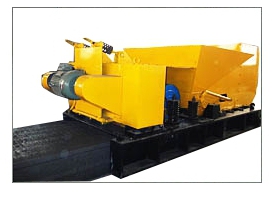Reinforced concrete floor slabs (PP) - products widely used in the construction of multi-storey industrial buildings, residential and non-residential buildings.
Often they are used in the construction of cottages and cottages, as well as for laying heating mains and tunnels. The scope of reinforced concrete products has been expanded due to ease of installation and universal use, because these building units can be combined with materials such as ordinary concrete, blocks, bricks and panels. It is only important to correctly calculate the load and take into account their weight.
Types of floor slabs
Depending on the use in a particular industry, reinforced concrete PPs may differ in their structure, weight, and may be monolithic (solid) or hollow (contain channels of different sections).

Equipment for the production of floor slabs may vary slightly, but in general the production process goes through the same steps.
So:
- Hollow products are used to create floors in residential and industrial buildings. The voids (or channels) are filled with air, which during the operation of buildings increases the thermal insulation of the room, and also reduces the noise level. Moreover, such plates are much lighter than monolithic structures.
- Lightweight hollow core slabs are used in building construction when it is necessary to reduce the load on the foundation.
- Solid channel PPs are suitable for creating communication systems.
- Continuous additional PPs participate in construction in the case when the floor slab plays the role of the bearing part of the structure.
- Ribbed reinforced concrete products are suitable for the construction of industrial buildings and non-residential premises, mainly due to the protruding edges in the lower part of the slab.
Technical characteristics of floor slabs
The height of the software does not exceed 220 mm. The weight of the floor slab ranges from 900 kg to 2500 kg and depends on the length and width.
Most often, reinforced concrete products are used in construction, the size of which is 6000 x 3000 mm, although the maximum length of the slab can reach 9000 mm. The cross section of voids inside the floor panels can be round, oval or in the form of arches of various heights. In this case, you can use universal equipment for the production of floor slabs.
What are the requirements for PP
Panels for overlapping must be durable, since it is on them that the main load is assigned both from the structure itself and from objects located inside.
Due to sufficient rigidity, high-quality plates do not bend under loads, which means that their fracture is excluded. When laying pay attention to the integrity: the products should not be faults and splits of more than 1 mm.
The right equipment for the production of floor slabs allows you to get reinforced concrete products that prevent the penetration of moisture into the structure, fire resistant, gas resistant and economical to operate. The presence of high-quality fittings provides sufficient rigidity and strength of the panels, and thanks to the internal voids, the process of laying internal communications is greatly facilitated.
Getting the PP form
Various reinforced concrete products are created by molding concrete mass. Overlapping panels are no exception. However, here, as in any production process, there are exceptions and features.This technology for the production of floor slabs is characterized by the use of many mechanisms. This is convenient when workshops or factories operate with a limited range.

The mold for the manufacture of PP is installed on a special vibrating table and fixed using an electromagnet in a stationary state. The reinforced mesh is laid in the prepared metal pallet, which is the key to the strength and rigidity of the future product.
On one side of the equipment there are holes through which special pipes enter - Poissons. They are needed to create voids inside the slabs. An reinforcing mesh is also superimposed on top, and the entire structure is neatly poured with concrete mortar. It should be mentioned that the lower layer of reinforcement is denser and the metal rods are thicker.

After the metal pallet is covered with a lid, the vibrating table makes the mold move, as a result of which the mixture is densely compacted. At the end of the process, the Poissons return to their places and voids remain in the slab. It is very convenient to use such a machine for the production of floor slabs, since the main process is carried out quickly and efficiently, which is very important when producing large batches of the same reinforced concrete products.
Finishing, steaming and heat treatment
Special tunnels (through passage), the height of which does not exceed 1 m, allow you to create a continuous cycle of work. A conveyor with molded floor slabs that are uniformly processed with steam slowly move inside. The length of the chambers and the speed of movement of the reinforced concrete products is designed so that the panels undergo high-quality processing. As a rule, this takes at least a day. After a day, finished floor slabs can be sent to the warehouse.
